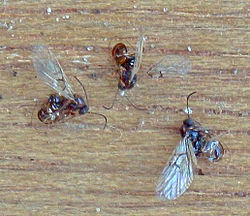| Neuroterus numismalis | |
|---|---|
 | |
| Silk button gall on pedunculate oak | |
| Scientific classification | |
| Kingdom: | Animalia |
| Phylum: | Arthropoda |
| Class: | Insecta |
| Order: | Hymenoptera |
| Family: | Cynipidae |
| Genus: | Neuroterus |
| Species: | N. numismalis |
| Binomial name | |
| Neuroterus numismalis Geoffroy in Fourcroy, 1785 | |
Neuroterus numismalis is a gall wasp that forms chemically induced leaf galls on oak trees. It has both bisexual and agamic (parthenogenetic) generations and forms two distinct galls on oak leaves, the silk button gall and blister gall. The galls can be very numerous with more than a thousand per leaf. [1]
